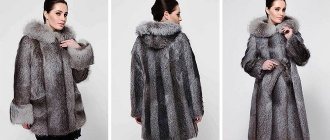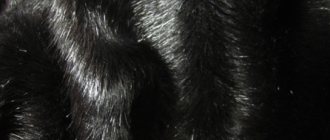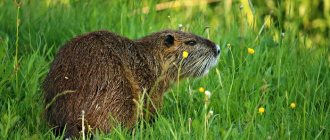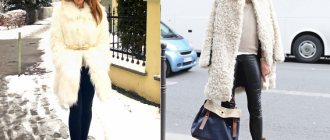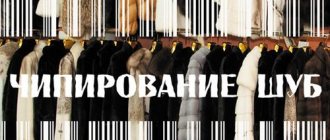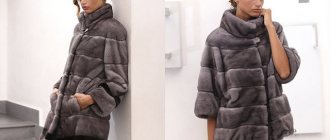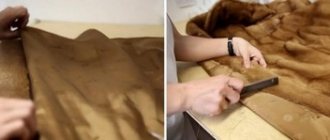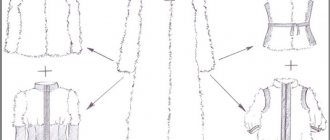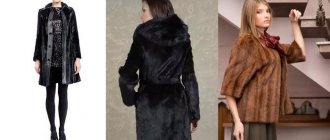Nutria fur structure
Nutria is a mammal also called the water rat or swamp beaver. From the name it is already clear that the animal is accustomed to moisture and a wet environment, which means its fur is designed for exactly this.
That is, the animal’s cover must protect it in any conditions:
- In severe frosts
- In the heat from overheating
- In water
- When leaving the water in the cold
- From fleas and other insects
That is why the material has a very interesting and rich structure, which is very clearly visible in large photos of nutria fur.
The material has the following features:
- Long and rigid guide pile
- Long whiskers that give the animal sensitivity
- Fluffy and abundant undercoat
The fur consists of 90-93% of the undercoat itself, which provides good protection from moisture and temperature changes. The undercoat hair is curled, which makes the fur fluffier and retains heat well.
The main advantages of mink
The peak of popularity of mink coats occurred in the mid-30s of the 20th century, when Hollywood stars began to appear in public more often in them. Mink fur is considered ideal in terms of quality and cost ratio among other fur-bearing animals. It is cheaper than sable, lynx and chinchilla, but more expensive than beaver. It is silky with thick underfluff, practical and comfortable to wear. It retains heat well and withstands moisture relatively easily, but in these indicators it is significantly inferior to beaver products.
Remember its advantages if you can’t decide what to choose: beaver or mink?
These include the following characteristics:
- delicate, soft and shiny fibers;
- retains heat well;
- a light weight;
- wear resistance;
- can last up to 10 seasons in a row.
Purchasing a mink coat will be more expensive compared to marten, ermine and arctic fox. Mink and beaver differ in price by almost twice, and sometimes even more.
Properties and characteristics
The characteristics of nutria fur speak largely in its favor, which is why many furriers choose this particular material for their products. Basic properties:
- Easily repels moisture
- Not afraid of moisture, rain, wet snow
- Dries quickly
- Retains heat even when wet
- Retains heat even in severe frost
- Easily withstands temperature changes
- Easily survives dry cleaning
- Resistant to mechanical stress: friction, tensile strength
It is these properties of fur that make products made from it durable and comfortable. In addition, nutria are quite easy to keep and grow.
Nutria fur varies in color. The natural cover of wild animals is usually a deep dark brown color with a slightly blue tint. However, livestock breeders have bred species with different skin colors:
- Blue-black
- Dark brown
- Chocolate brown
- Gray
- White
- Light beige
- Beige
Designers have been combining different colors for a long time, creating beautiful masterpieces from this fur. The price of nutria fur is not high even compared to beaver skins. This allows the material to be used even for inexpensive products.
Ready-made or custom-made product?
The market offers a huge selection of ready-made fur coats made from natural fur, but if you want something special, then you should contact a fur tailoring studio .
Experienced specialists will develop a model based on your figure and help you decide on the style, color and even type of fur. The downside of going to a studio is the wait. Making a fur coat is a labor-intensive process, but the result will exceed all expectations.
Is nutria fur warm?
Many people wonder: is nutria fur warm or not? This question arises primarily due to the appearance of the material with long guard hairs and vibrissae. These long, protruding hair shafts make the fur feel loose and quite cold. However, this impression is wrong.
- Fur was created by nature primarily on small animals, which means they have a high risk of hypothermia.
- This risk increases significantly due to constant contact with the aquatic environment.
- The fur has a warm undercoat, the hairs of which have a twisted structure.
- This creates an air cushion inside and between the hairs, which has good thermal insulation properties.
- Again, thanks to this pillow, the fur is breathable and does not feel hot in a warm environment.
However, nutria fur is not as warm as mink or beaver fur. But even in severe frost you won’t freeze in a nutria fur coat.
Fur processing options
Nutria fur has a lot of aesthetic properties that allow it to be used in its original form.
Main visual characteristics of fur:
- Deep colors
- Bright, silky shine
- A light weight
- Dense structure
- Soft, pleasant to the touch texture
Thick skin and good undercoat make it easy to sew fur. The canvas, created from small pieces, will be as durable as ordinary skins.
The fluffy undercoat makes it difficult to cut from the skins, as it sheds abundantly when trimmed. Considering the low price of fur, many designers try to create products from whole skins.
The rich structure of the material also opens up a lot of possibilities for processing and changing its appearance. Types of fur processing:
- Fur trimming
- Plucking whiskers
- Combination of these processing methods
The sheared nutria fur is more similar to mink fur, which makes it more noble. However, when cutting, long hair is cut in the very middle, that is, in the thickest place.
Because of this, rough bristles form on the fur, which spoils the tactile sensation when the skin comes into contact with the material. Mink fur in this case will be more silky and delicate. At the same time, from a distance, the externally trimmed nutria skins look like mink.
Plucked nutria fur is completely free of long hair. This makes it more fluffy and tender. Outwardly, it looks like a sheared mink, a beaver. However, this material retains heat less well and wears out faster. Due to the removal of shiny hairs, the fur also loses its characteristic refined shine.
In order for the fur to have a noble appearance and at the same time remain pleasant to the touch, it is subjected to two methods of processing at once - shearing and plucking. Thanks to this, it looks beautiful and does not become excessively rigid.
Important! There is a single rule for all types of fur: the more the skin has been processed, the more delicate and less wear-resistant it becomes. Nutria fur treated in all ways will withstand wear for 2-3 seasons.
Buyer's opinion about a mouton fur coat
Alexandra : Mouton fur coats are one of the most practical and durable, so I didn’t have to think long about what to wear in winter. Since I lead an active lifestyle, spend a lot of time outside with my dog and child, and drive a car, I chose the appropriate model: just below the hip, loose fit, with a cozy hood trimmed with steppe fox. It probably looks more like a jacket, but that’s what suits me about it. A zipper is the best option for me if I need to get ready somewhere quickly.
My fur coat looks very democratic, and the dressing of the skins is very high quality and of good quality (apparently, this affected the price: it was somewhat more expensive than other mouton fur coats). I chose a light shade: in winter I want bright colors, the fur coat is painted beige-golden, and the fox trim on the hood is perfect for it.
My fur coat looks great with heels and sports shoes. The same goes for clothes: it perfectly complements both a feminine look and a youthful look with jeans.
The only thing I changed in the fur coat was to remove the elastic bands that tightened the hem. I couldn't appreciate their functionality, so I got rid of them.
Well, no one canceled the accessories: I change scarves, hats, and bags - you can update your look for every occasion.
Finally, I hasten to reassure those who think that mouton fur coats are heavy. This is wrong! Modern technologies have significantly lightened this naturally heavy fur, and I feel light, warm and comfortable in my fur coat.
How to care for fur
Due to its wear resistance and versatility, this material is quite easy to care for. Why it is valued by owners of nutria products.
However, with proper care, the service life of these products can be extended to 10-12 years. Moreover, all this time things will look beautiful and aesthetically pleasing.
Care methods:
- Combing. Since the fur has a fluffy undercoat, the fallen hairs may not be removed, but remain in the structure, forming tufts and tangles. This spoils the appearance of the product. Therefore, the fur must be brushed regularly with a stiff brush.
- If the fur becomes dirty, you can wash it with shampoo foam and then wipe it several times with a wet cloth. Wet salt is also good for removing heavy stains.
- If your fur coat gets wet outside, you need to shake it well several times to remove excess moisture and then let it air dry.
- In summer, fur coats should be ventilated and hung in clean air. It is important that the fur is not exposed to sunlight.
- To prevent moths from getting into your fur, it is enough to use bags with aromatic herbs: lavender, mint, sage.
Thanks to these simple techniques, the product will remain beautiful and stylish for a long time.
